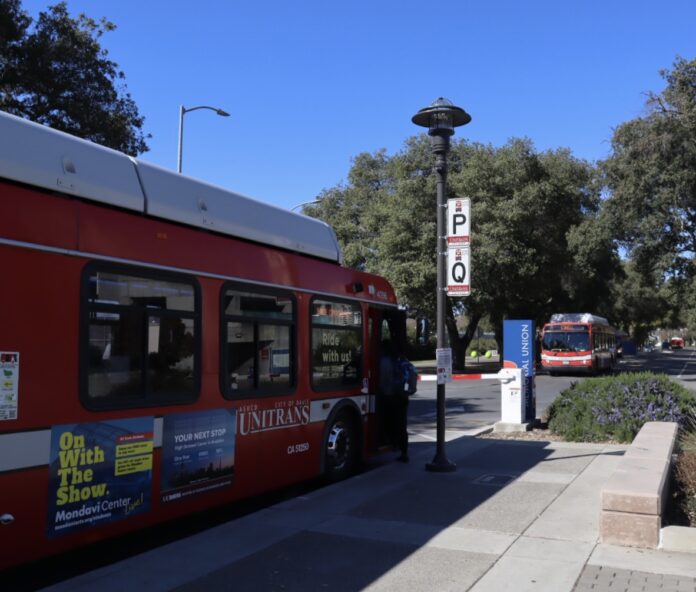Detours for Unitrans buses is standard procedure during line obstructions, according to Unitrans general manager
By RACHEL SHEY — city@theaggie.org
On Feb. 10, around 6 a.m., a road rage incident that occurred on Mace Boulevard caused Unitrans buses to temporarily reroute their lines. The dispute took place between two drivers and ultimately led to a manhunt involving helicopters, according to California Highway Patrol Officer Rodney Fitzhugh.
“They were both traveling westbound 80, east of Mace Boulevard, [when] both vehicles exited the freeway,” Fitzhugh said. “After they exited the freeway, one of the vehicles shot at the other vehicle. There were a couple of stray bullets that missed the target and hit another vehicle unrelated to the incident. The suspect’s vehicle tried to re-enter the freeway after it crossed over, lost control of the vehicle and then collided with a fence.”
Fitzhugh told the Davis Enterprise that the suspect was detained along 2nd Street. During this incident, which spanned several hours, two Unitrans bus lines, which generally travel on Mace Boulevard, were detoured. The P and Q lines skipped a few stops while Mace Boulevard was closed.
ASUCD Unitrans General Manager Jeffrey Flynn said that such detours happen with great frequency, though usually for more quotidian reasons. Unitrans buses are detoured on a daily basis due to the system’s expansive coverage. There are often incidents occurring somewhere around the city or campus, according to Flynn.
“Having to detour because of a vehicle collision or some type of police incident or something or unnotified construction activity is very frequent,” Flynn said. “Sometimes it happens on campus or in the city. We are very well-versed in trying to be nimble and respond to detours as quickly as possible. Interestingly enough, we were detoured on the P and Q lines on the 10th due to this incident on Mace, and on the 15th, Mace was shut down again for 12 hours, so we were doing it all over again.”
During a traffic-obstructing incident, the Unitrans dispatcher uses all available information to quickly assemble a detour while trying to miss the least possible stops. The dispatcher then transmits the detour to bus drivers and checks using GPS that the drivers are following the detour, Flynn explained. The detours can be created in just a few minutes.
“The dispatcher uses whatever information they have at their fingertips in the moment to get buses around a closure, and with our route supervisor, who is mobile and in a vehicle, they go out to the scene and try to get more information and create a more permanent detour that we can adjust to and share with all of our drivers,” Flynn said. “There’s often two detours we do: one that’s immediate, responding to something unknown, and then a more permanent one that is widely shared with subsequent drivers on the route.”
It’s important that the drivers understand the detour, according to Flynn. Dispatchers require the driver to repeat the detour back to them to ensure that they understood the detour route. If the driver doesn’t understand the detour, he or she is supposed to stop and wait for a route supervisor to drive out and assist them. Route supervisors sometimes serve as a pace car to guide them through the detour, driving ahead for the bus to follow, according to Flynn.
Flynn encourages all Unitrans customers to check the Unitrans website, Facebook and Instagram for updates on detours. For those relying on the buses to make it to school or work on time, the website is where the most up-to-date information can be found.
“We encourage people to follow us on Facebook or Instagram, where we post these kind of detours,” Flynn said. “It’s very hard to get customers to find our information. Not many people are signed up for our Facebook page or Instagram page, and a lot of people don’t use our website. We really want to steer people to our website, our Facebook and Instagram pages for of-the-moment detour information. We try to post detours and missed stops as they come up on those services, so that’s the best place to get the information.”
Fitzhugh encourages people to drive courteously and to avoid becoming involved in road rage behavior. Collecting information about aggressive motorists is also a good idea in case violence occurs. Calling 911 is a great first step.
“If someone is driving aggressively near you, get good witness information, should you find yourself in a road rage incident,” Fitzhugh said. “Do not engage in that road rage behavior, just be a good witness.”
Written by: Rachel Shey — city@theaggie.org




